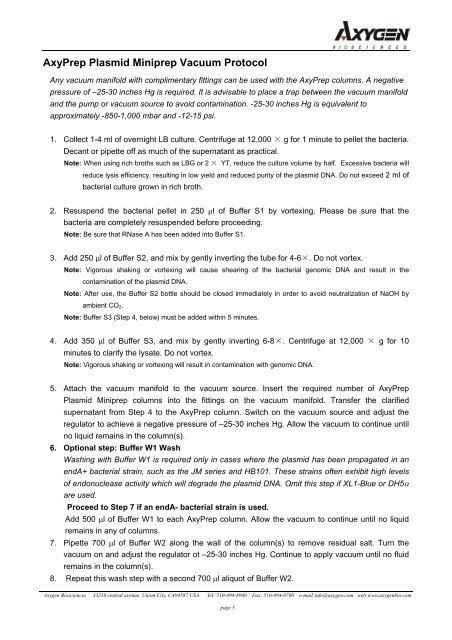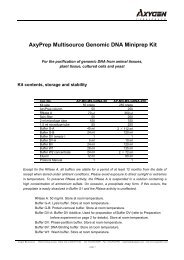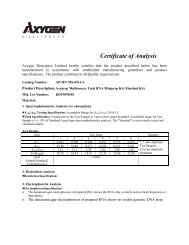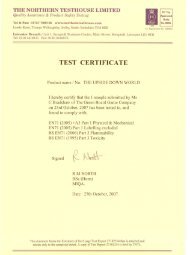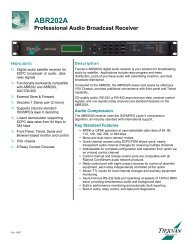Create successful ePaper yourself
Turn your PDF publications into a flip-book with our unique Google optimized e-Paper software.
<strong>AxyPrep</strong> <strong>Plasmid</strong> <strong>Miniprep</strong> Vacuum Protocol<br />
Any vacuum manifold with complimentary fittings can be used with the <strong>AxyPrep</strong> columns. A negative<br />
pressure of –25-30 inches Hg is required. It is advisable to place a trap between the vacuum manifold<br />
and the pump or vacuum source to avoid contamination. -25-30 inches Hg is equivalent to<br />
approximately -850-1,000 mbar and -12-15 psi.<br />
1. Collect 1-4 ml of overnight LB culture. Centrifuge at 12,000 × g for 1 minute to pellet the bacteria.<br />
Decant or pipette off as much of the supernatant as practical.<br />
Note: When using rich broths such as LBG or 2 × YT, reduce the culture volume by half. Excessive bacteria will<br />
reduce lysis efficiency, resulting in low yield and reduced purity of the plasmid DNA. Do not exceed 2 ml of<br />
bacterial culture grown in rich broth.<br />
2. Resuspend the bacterial pellet in 250 μl of Buffer S1 by vortexing. Please be sure that the<br />
bacteria are completely resuspended before proceeding.<br />
Note: Be sure that RNase A has been added into Buffer S1.<br />
3. Add 250 μl of Buffer S2, and mix by gently inverting the tube for 4-6×. Do not vortex.<br />
Note: Vigorous shaking or vortexing will cause shearing of the bacterial genomic DNA and result in the<br />
contamination of the plasmid DNA.<br />
Note: After use, the Buffer S2 bottle should be closed immediately in order to avoid neutralization of NaOH by<br />
ambient CO 2 .<br />
Note: Buffer S3 (Step 4, below) must be added within 5 minutes.<br />
4. Add 350 μl of Buffer S3, and mix by gently inverting 6-8×. Centrifuge at 12,000 × g for 10<br />
minutes to clarify the lysate. Do not vortex.<br />
Note: Vigorous shaking or vortexing will result in contamination with genomic DNA.<br />
5. Attach the vacuum manifold to the vacuum source. Insert the required number of <strong>AxyPrep</strong><br />
<strong>Plasmid</strong> <strong>Miniprep</strong> columns into the fittings on the vacuum manifold. Transfer the clarified<br />
supernatant from Step 4 to the <strong>AxyPrep</strong> column. Switch on the vacuum source and adjust the<br />
regulator to achieve a negative pressure of –25-30 inches Hg. Allow the vacuum to continue until<br />
no liquid remains in the column(s).<br />
6. Optional step: Buffer W1 Wash<br />
Washing with Buffer W1 is required only in cases where the plasmid has been propagated in an<br />
endA+ bacterial strain, such as the JM series and HB101. These strains often exhibit high levels<br />
of endonuclease activity which will degrade the plasmid DNA. Omit this step if XL1-Blue or DH5α<br />
are used.<br />
Proceed to Step 7 if an endA- bacterial strain is used.<br />
Add 500 μl of Buffer W1 to each <strong>AxyPrep</strong> column. Allow the vacuum to continue until no liquid<br />
remains in any of columns.<br />
7. Pipette 700 μl of Buffer W2 along the wall of the column(s) to remove residual salt. Turn the<br />
vacuum on and adjust the regulator ot –25-30 inches Hg. Continue to apply vacuum until no fluid<br />
remains in the column(s).<br />
8. Repeat this wash step with a second 700 μl aliquot of Buffer W2.<br />
Axygen Biosciences 33210 central avenue, Union City, CA94587 USA Tel: 510-494-8900 Fax: 510-494-0700 e-mail:info@axygen.com web:www.axygenbio.com<br />
page 3


